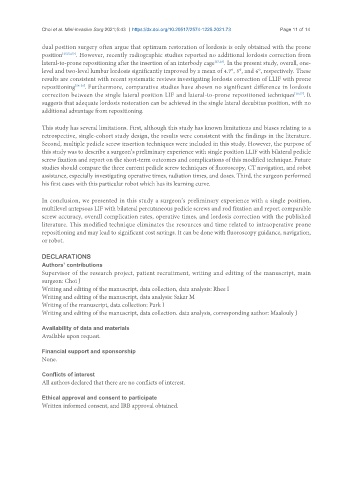Page 447 - Read Online
P. 447
Choi et al. Mini-invasive Surg 2021;5:43 https://dx.doi.org/10.20517/2574-1225.2021.73 Page 11 of 14
dual position surgery often argue that optimum restoration of lordosis is only obtained with the prone
position [25,52,53] . However, recently radiographic studies reported no additional lordosis correction from
lateral-to-prone repositioning after the insertion of an interbody cage [27,28] . In the present study, overall, one-
level and two-level lumbar lordosis significantly improved by a mean of 4.7°, 5°, and 6°, respectively. These
results are consistent with recent systematic reviews investigating lordosis correction of LLIF with prone
repositioning [54-56] . Furthermore, comparative studies have shown no significant difference in lordosis
correction between the single lateral position LIF and lateral-to-prone repositioned techniques [18,57] . It
suggests that adequate lordosis restoration can be achieved in the single lateral decubitus position, with no
additional advantage from repositioning.
This study has several limitations. First, although this study has known limitations and biases relating to a
retrospective, single-cohort study design, the results were consistent with the findings in the literature.
Second, multiple pedicle screw insertion techniques were included in this study. However, the purpose of
this study was to describe a surgeon’s preliminary experience with single position LLIF with bilateral pedicle
screw fixation and report on the short-term outcomes and complications of this modified technique. Future
studies should compare the three current pedicle screw techniques of fluoroscopy, CT navigation, and robot
assistance, especially investigating operative times, radiation times, and doses. Third, the surgeon performed
his first cases with this particular robot which has its learning curve.
In conclusion, we presented in this study a surgeon’s preliminary experience with a single position,
multilevel antepsoas LIF with bilateral percutaneous pedicle screws and rod fixation and report comparable
screw accuracy, overall complication rates, operative times, and lordosis correction with the published
literature. This modified technique eliminates the resources and time related to intraoperative prone
repositioning and may lead to significant cost savings. It can be done with fluoroscopy guidance, navigation,
or robot.
DECLARATIONS
Authors’ contributions
Supervisor of the research project, patient recruitment, writing and editing of the manuscript, main
surgeon: Choi J
Writing and editing of the manuscript, data collection, data analysis: Rhee I
Writing and editing of the manuscript, data analysis: Sakar M
Writing of the manuscript, data collection: Park I
Writing and editing of the manuscript, data collection. data analysis, corresponding author: Maalouly J
Availability of data and materials
Available upon request.
Financial support and sponsorship
None.
Conflicts of interest
All authors declared that there are no conflicts of interest.
Ethical approval and consent to participate
Written informed consent, and IRB approval obtained.

